Report on Methicillin-Resistant Staphylococcus Aureus (MRSA) Overview
VerifiedAdded on 2022/10/11
|14
|1050
|22
Report
AI Summary
This report provides a comprehensive overview of Methicillin-resistant Staphylococcus aureus (MRSA), a bacterium resistant to several antibiotics. It discusses the types of MRSA, including healthcare-associated (HA-MRSA) and community-associated (CA-MRSA), detailing their symptoms, risk factors, diagnosis methods like urine, blood, sputum, and wound cultures, and treatment options. The report emphasizes the importance of prevention through hand hygiene, avoiding sharing personal items, wound care, and proper sanitation. Management strategies such as quarantine, handwashing, protective gear, and disinfection are also highlighted. It concludes with interesting facts about MRSA and recommendations for seeking medical attention for potentially infected wounds. The content aims to educate on MRSA's impact and management.
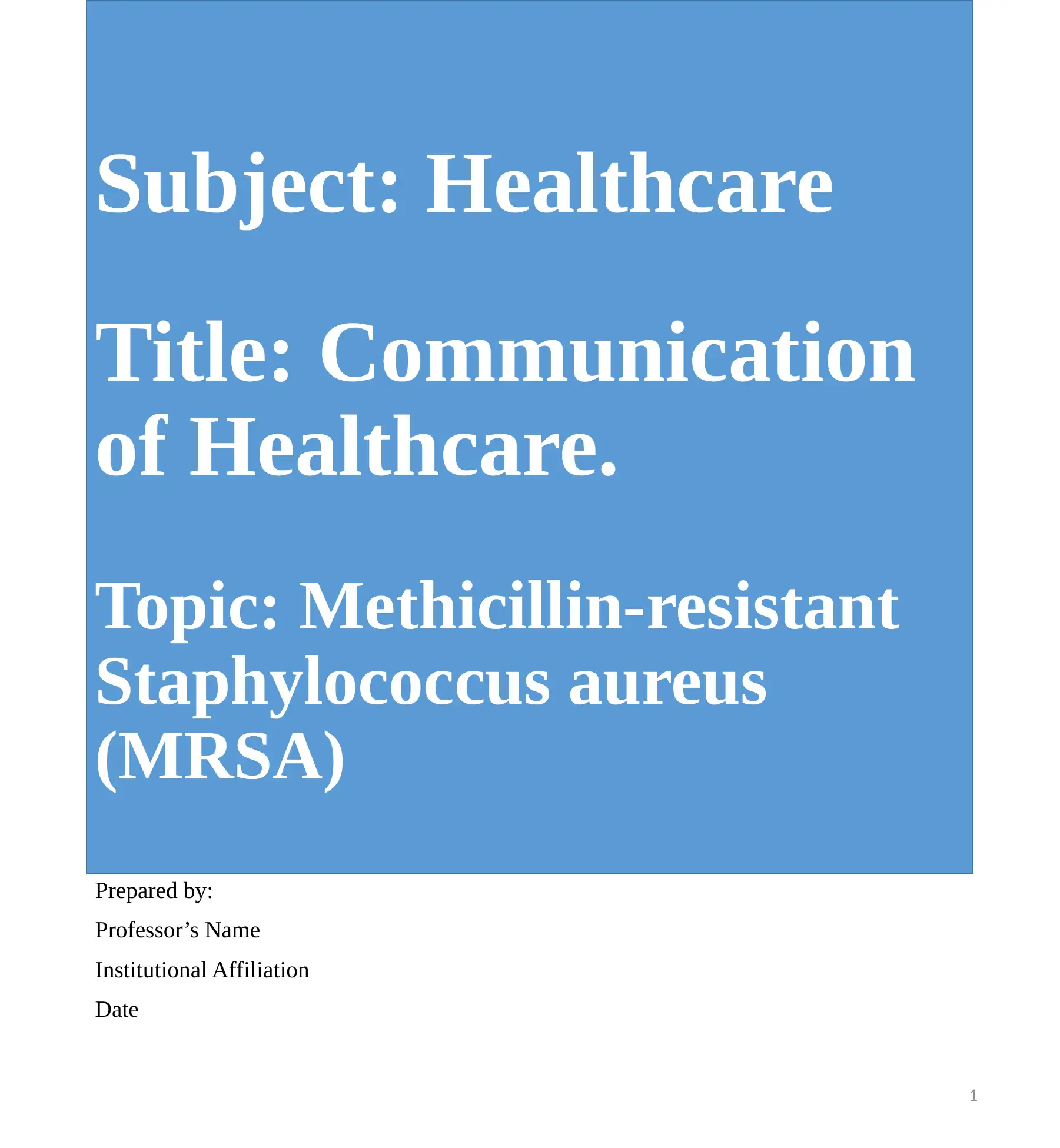
1
Subject: Healthcare
Title: Communication
of Healthcare.
Topic: Methicillin-resistant
Staphylococcus aureus
(MRSA)
Prepared by:
Professor’s Name
Institutional Affiliation
Date
Subject: Healthcare
Title: Communication
of Healthcare.
Topic: Methicillin-resistant
Staphylococcus aureus
(MRSA)
Prepared by:
Professor’s Name
Institutional Affiliation
Date
Paraphrase This Document
Need a fresh take? Get an instant paraphrase of this document with our AI Paraphraser
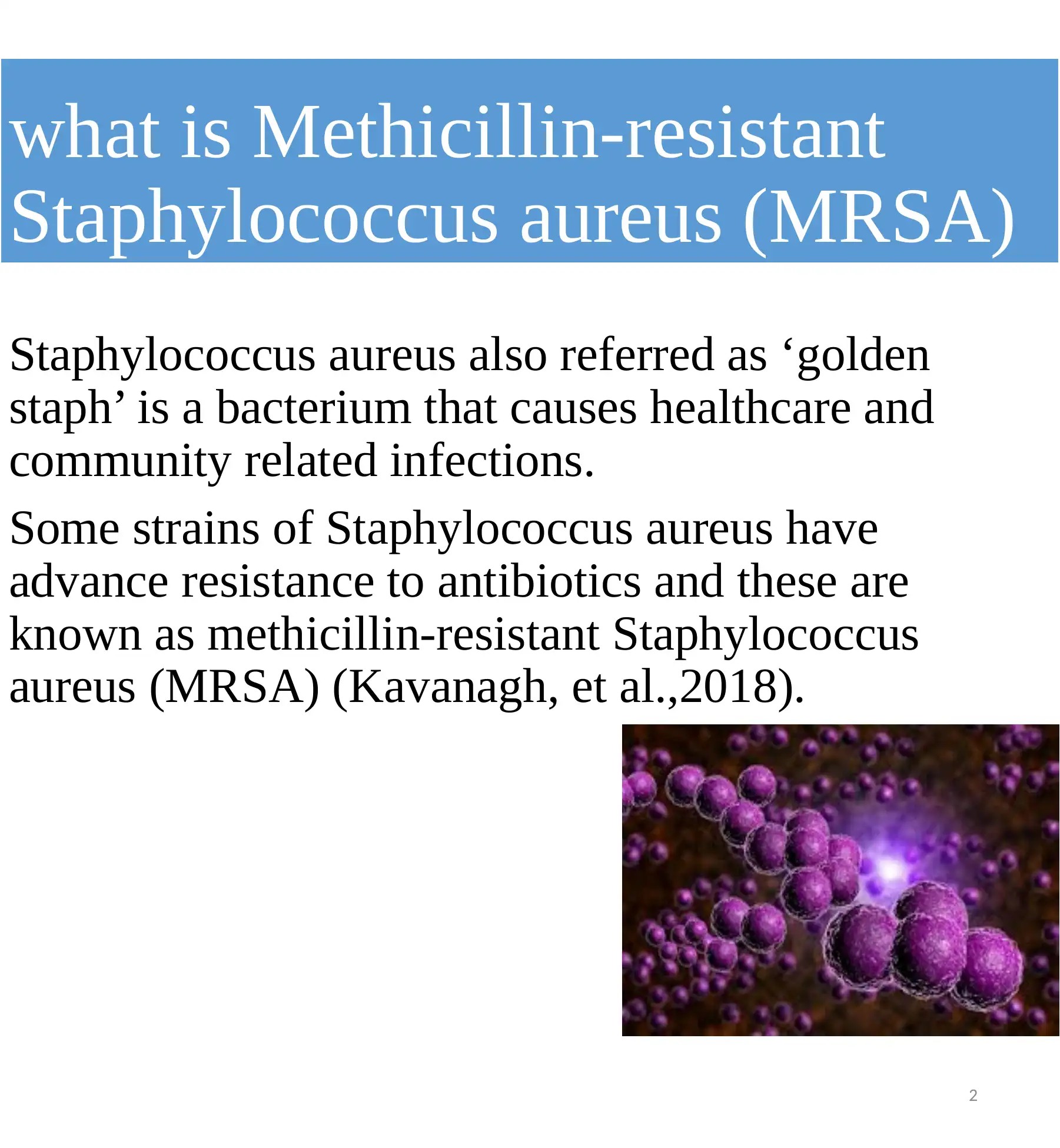
2
what is Methicillin-resistant
Staphylococcus aureus (MRSA)
Staphylococcus aureus also referred as ‘golden
staph’ is a bacterium that causes healthcare and
community related infections.
Some strains of Staphylococcus aureus have
advance resistance to antibiotics and these are
known as methicillin-resistant Staphylococcus
aureus (MRSA) (Kavanagh, et al.,2018).
what is Methicillin-resistant
Staphylococcus aureus (MRSA)
Staphylococcus aureus also referred as ‘golden
staph’ is a bacterium that causes healthcare and
community related infections.
Some strains of Staphylococcus aureus have
advance resistance to antibiotics and these are
known as methicillin-resistant Staphylococcus
aureus (MRSA) (Kavanagh, et al.,2018).
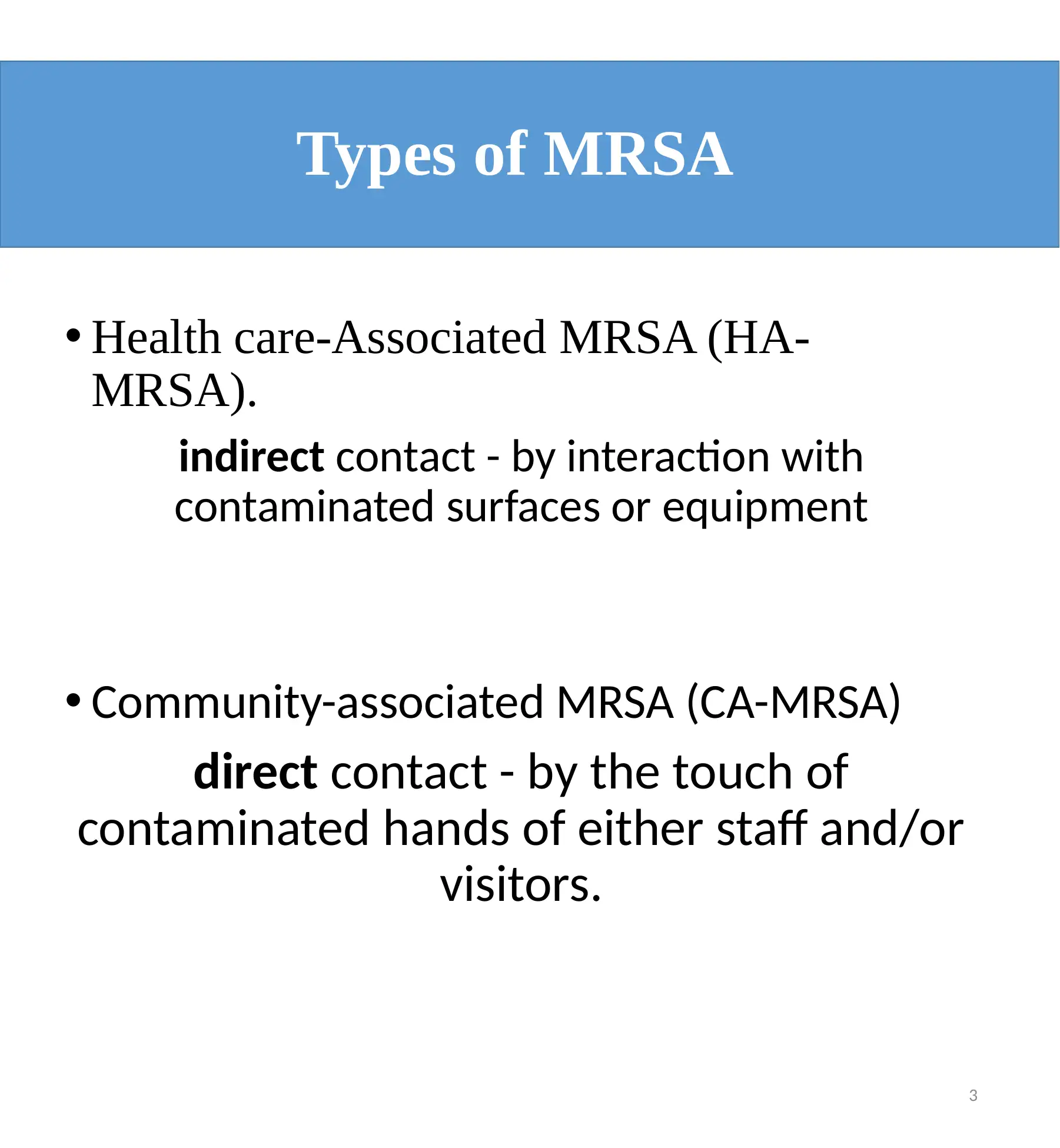
3
Types of MRSA
• Health care-Associated MRSA (HA-
MRSA).
indirect contact - by interaction with
contaminated surfaces or equipment
• Community-associated MRSA (CA-MRSA)
direct contact - by the touch of
contaminated hands of either staff and/or
visitors.
Types of MRSA
• Health care-Associated MRSA (HA-
MRSA).
indirect contact - by interaction with
contaminated surfaces or equipment
• Community-associated MRSA (CA-MRSA)
direct contact - by the touch of
contaminated hands of either staff and/or
visitors.
⊘ This is a preview!⊘
Do you want full access?
Subscribe today to unlock all pages.

Trusted by 1+ million students worldwide
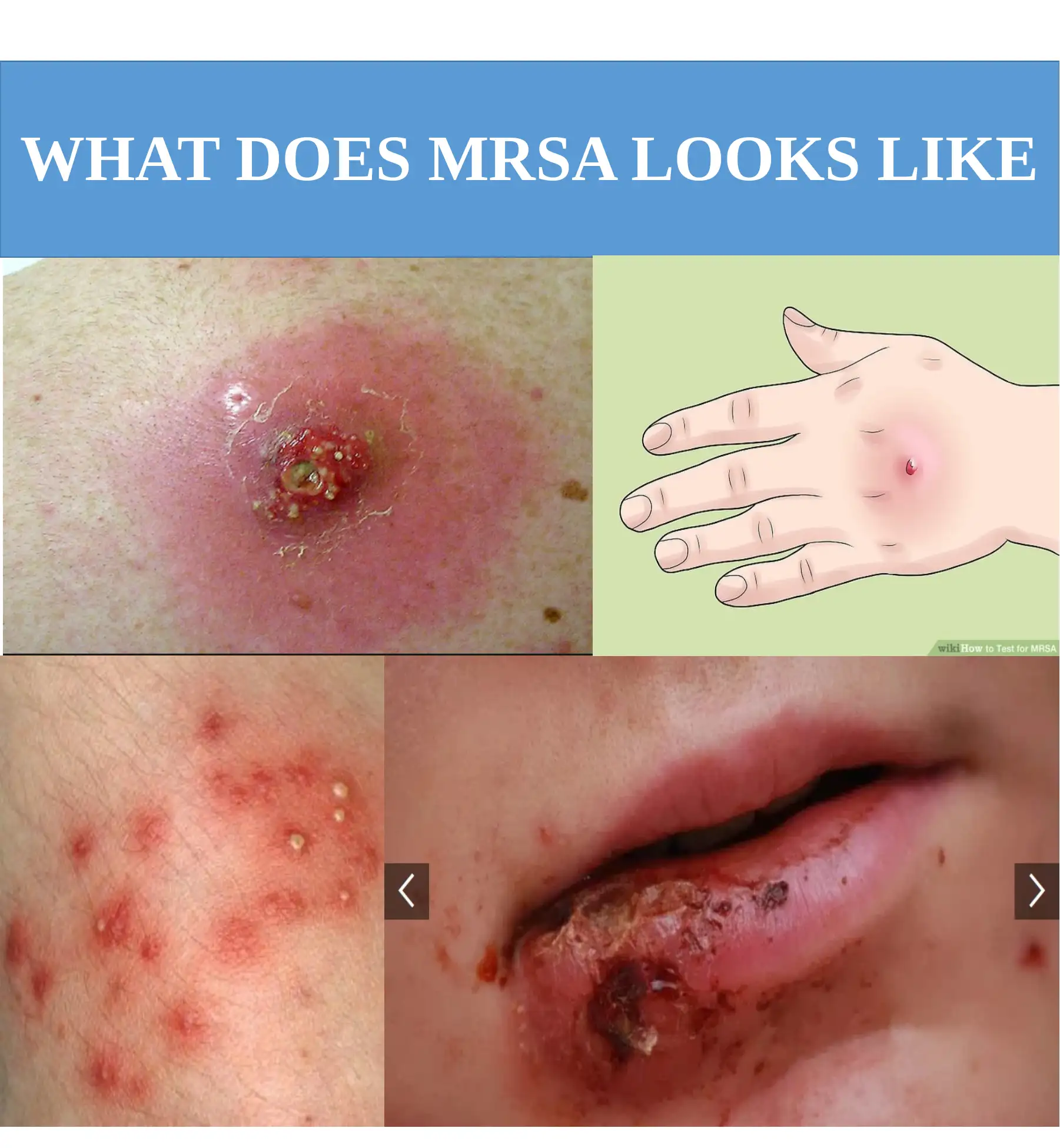
4
WHAT DOES MRSA LOOKS LIKE
WHAT DOES MRSA LOOKS LIKE
Paraphrase This Document
Need a fresh take? Get an instant paraphrase of this document with our AI Paraphraser
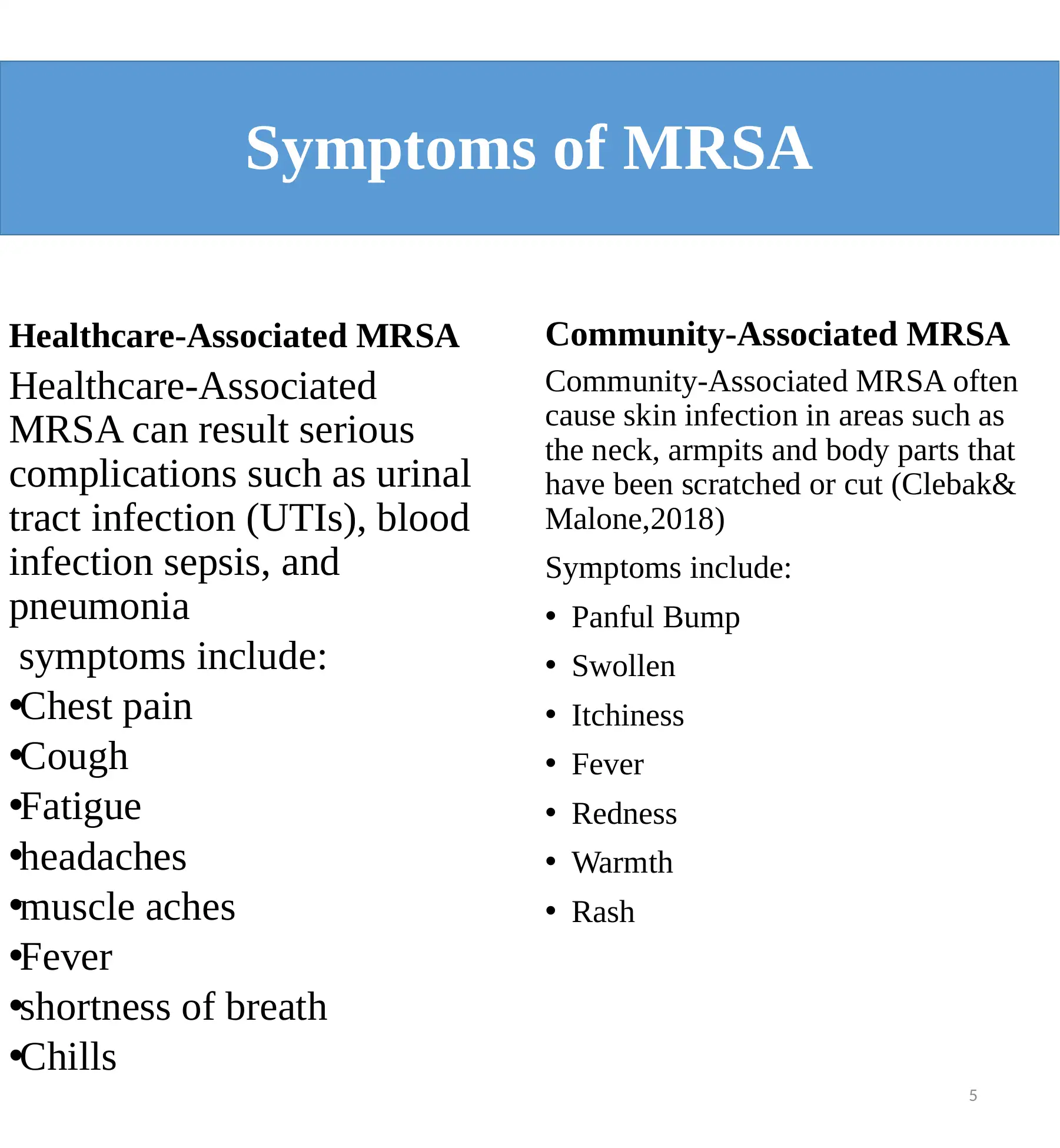
5
Symptoms of MRSA
Healthcare-Associated MRSA
Healthcare-Associated
MRSA can result serious
complications such as urinal
tract infection (UTIs), blood
infection sepsis, and
pneumonia
symptoms include:
•Chest pain
•Cough
•Fatigue
•headaches
•muscle aches
•Fever
•shortness of breath
•Chills
Community-Associated MRSA
Community-Associated MRSA often
cause skin infection in areas such as
the neck, armpits and body parts that
have been scratched or cut (Clebak&
Malone,2018)
Symptoms include:
• Panful Bump
• Swollen
• Itchiness
• Fever
• Redness
• Warmth
• Rash
Symptoms of MRSA
Healthcare-Associated MRSA
Healthcare-Associated
MRSA can result serious
complications such as urinal
tract infection (UTIs), blood
infection sepsis, and
pneumonia
symptoms include:
•Chest pain
•Cough
•Fatigue
•headaches
•muscle aches
•Fever
•shortness of breath
•Chills
Community-Associated MRSA
Community-Associated MRSA often
cause skin infection in areas such as
the neck, armpits and body parts that
have been scratched or cut (Clebak&
Malone,2018)
Symptoms include:
• Panful Bump
• Swollen
• Itchiness
• Fever
• Redness
• Warmth
• Rash
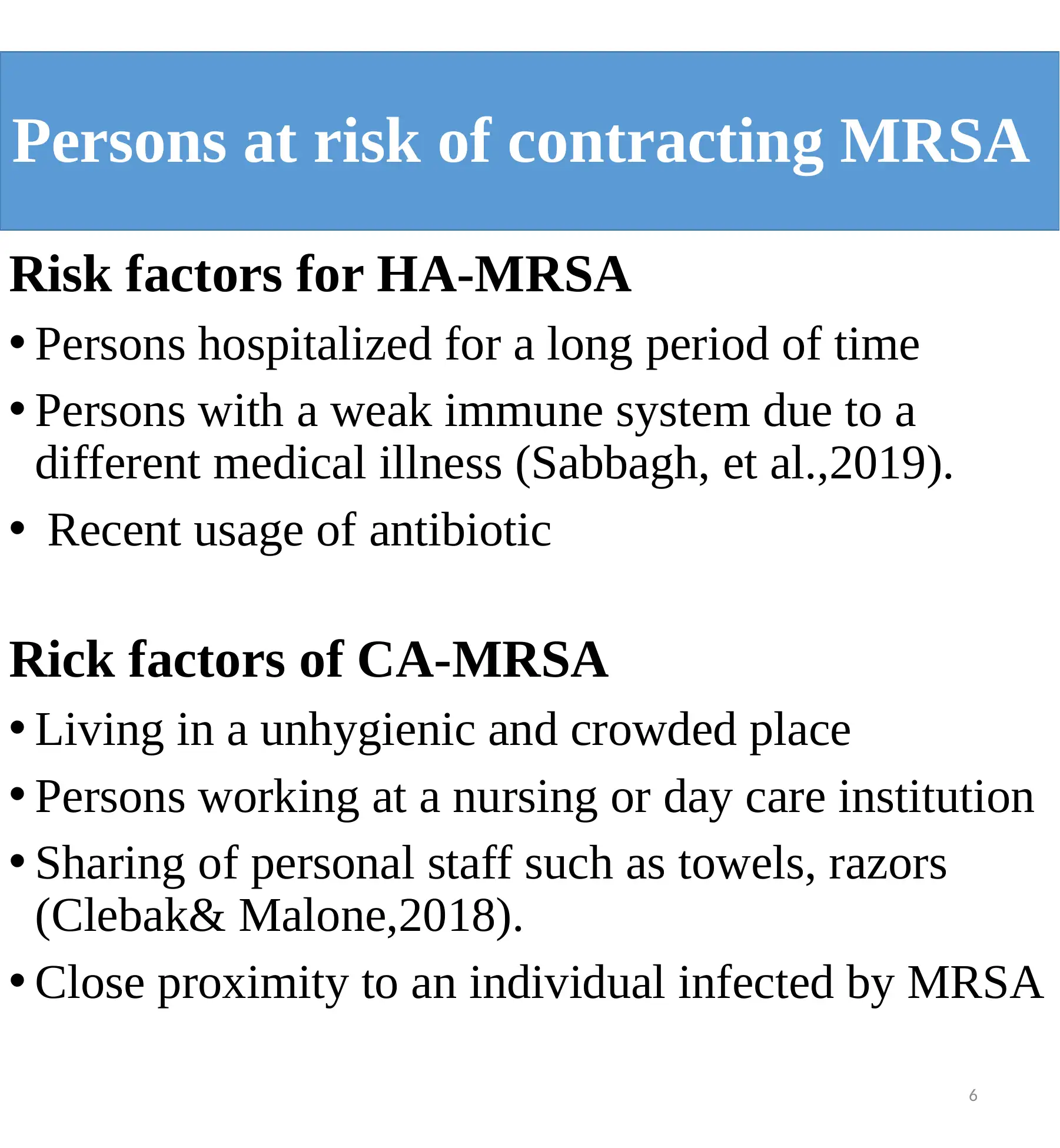
6
Persons at risk of contracting MRSA
Risk factors for HA-MRSA
• Persons hospitalized for a long period of time
• Persons with a weak immune system due to a
different medical illness (Sabbagh, et al.,2019).
• Recent usage of antibiotic
Rick factors of CA-MRSA
• Living in a unhygienic and crowded place
• Persons working at a nursing or day care institution
• Sharing of personal staff such as towels, razors
(Clebak& Malone,2018).
• Close proximity to an individual infected by MRSA
Persons at risk of contracting MRSA
Risk factors for HA-MRSA
• Persons hospitalized for a long period of time
• Persons with a weak immune system due to a
different medical illness (Sabbagh, et al.,2019).
• Recent usage of antibiotic
Rick factors of CA-MRSA
• Living in a unhygienic and crowded place
• Persons working at a nursing or day care institution
• Sharing of personal staff such as towels, razors
(Clebak& Malone,2018).
• Close proximity to an individual infected by MRSA
⊘ This is a preview!⊘
Do you want full access?
Subscribe today to unlock all pages.

Trusted by 1+ million students worldwide
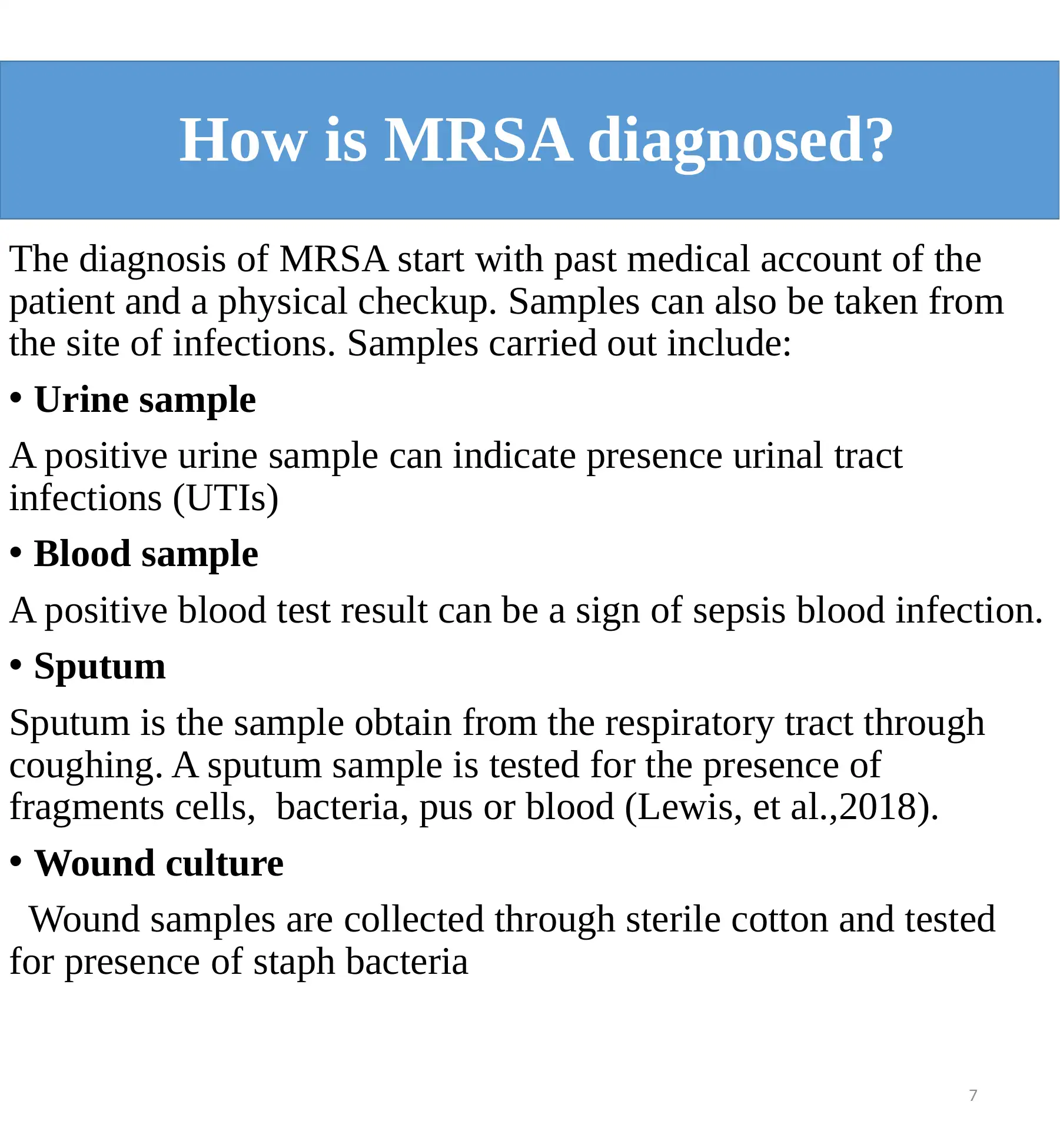
7
How is MRSA diagnosed?
The diagnosis of MRSA start with past medical account of the
patient and a physical checkup. Samples can also be taken from
the site of infections. Samples carried out include:
• Urine sample
A positive urine sample can indicate presence urinal tract
infections (UTIs)
• Blood sample
A positive blood test result can be a sign of sepsis blood infection.
• Sputum
Sputum is the sample obtain from the respiratory tract through
coughing. A sputum sample is tested for the presence of
fragments cells, bacteria, pus or blood (Lewis, et al.,2018).
• Wound culture
Wound samples are collected through sterile cotton and tested
for presence of staph bacteria
How is MRSA diagnosed?
The diagnosis of MRSA start with past medical account of the
patient and a physical checkup. Samples can also be taken from
the site of infections. Samples carried out include:
• Urine sample
A positive urine sample can indicate presence urinal tract
infections (UTIs)
• Blood sample
A positive blood test result can be a sign of sepsis blood infection.
• Sputum
Sputum is the sample obtain from the respiratory tract through
coughing. A sputum sample is tested for the presence of
fragments cells, bacteria, pus or blood (Lewis, et al.,2018).
• Wound culture
Wound samples are collected through sterile cotton and tested
for presence of staph bacteria
Paraphrase This Document
Need a fresh take? Get an instant paraphrase of this document with our AI Paraphraser
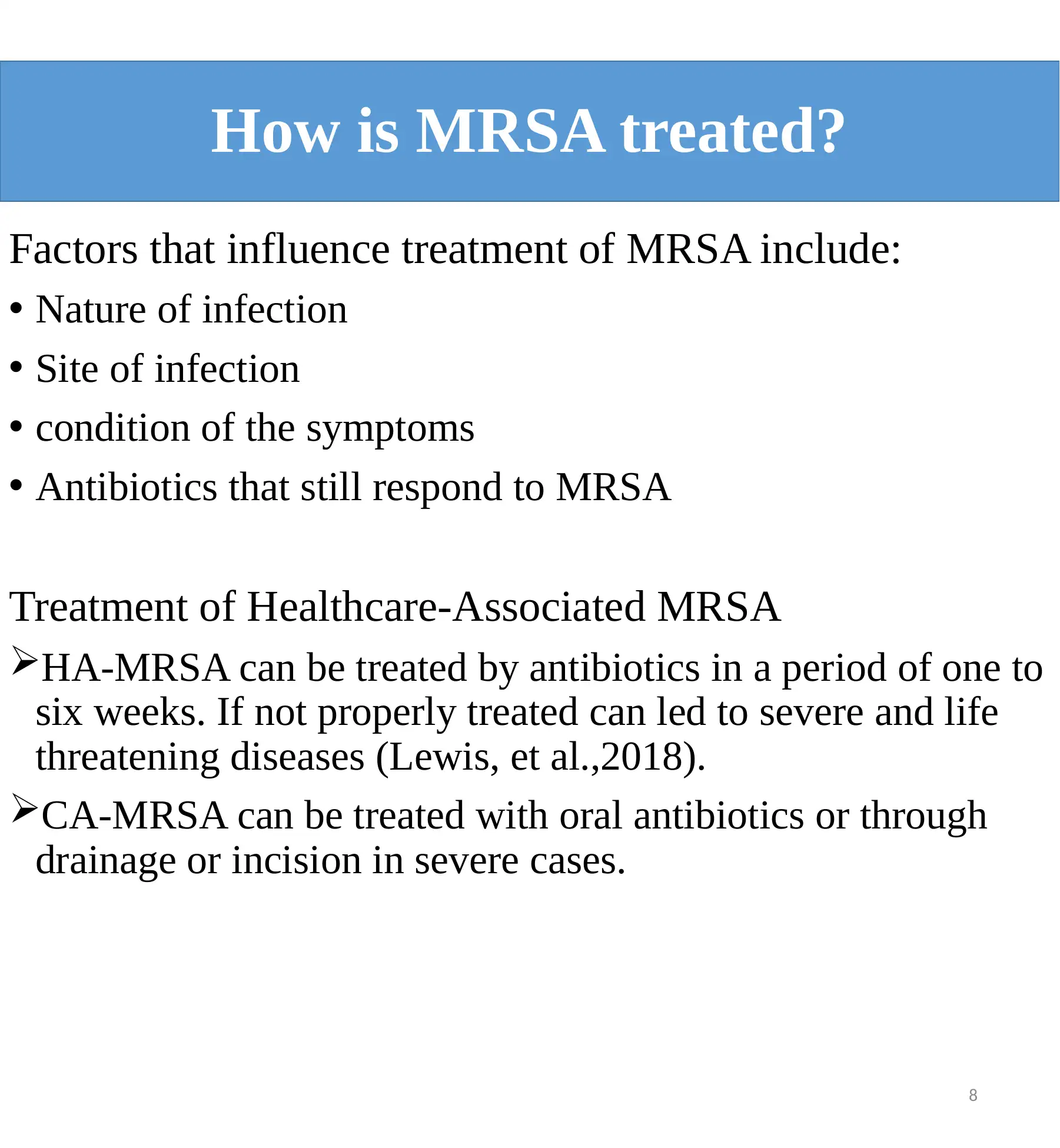
8
How is MRSA treated?
Factors that influence treatment of MRSA include:
• Nature of infection
• Site of infection
• condition of the symptoms
• Antibiotics that still respond to MRSA
Treatment of Healthcare-Associated MRSA
HA-MRSA can be treated by antibiotics in a period of one to
six weeks. If not properly treated can led to severe and life
threatening diseases (Lewis, et al.,2018).
CA-MRSA can be treated with oral antibiotics or through
drainage or incision in severe cases.
How is MRSA treated?
Factors that influence treatment of MRSA include:
• Nature of infection
• Site of infection
• condition of the symptoms
• Antibiotics that still respond to MRSA
Treatment of Healthcare-Associated MRSA
HA-MRSA can be treated by antibiotics in a period of one to
six weeks. If not properly treated can led to severe and life
threatening diseases (Lewis, et al.,2018).
CA-MRSA can be treated with oral antibiotics or through
drainage or incision in severe cases.
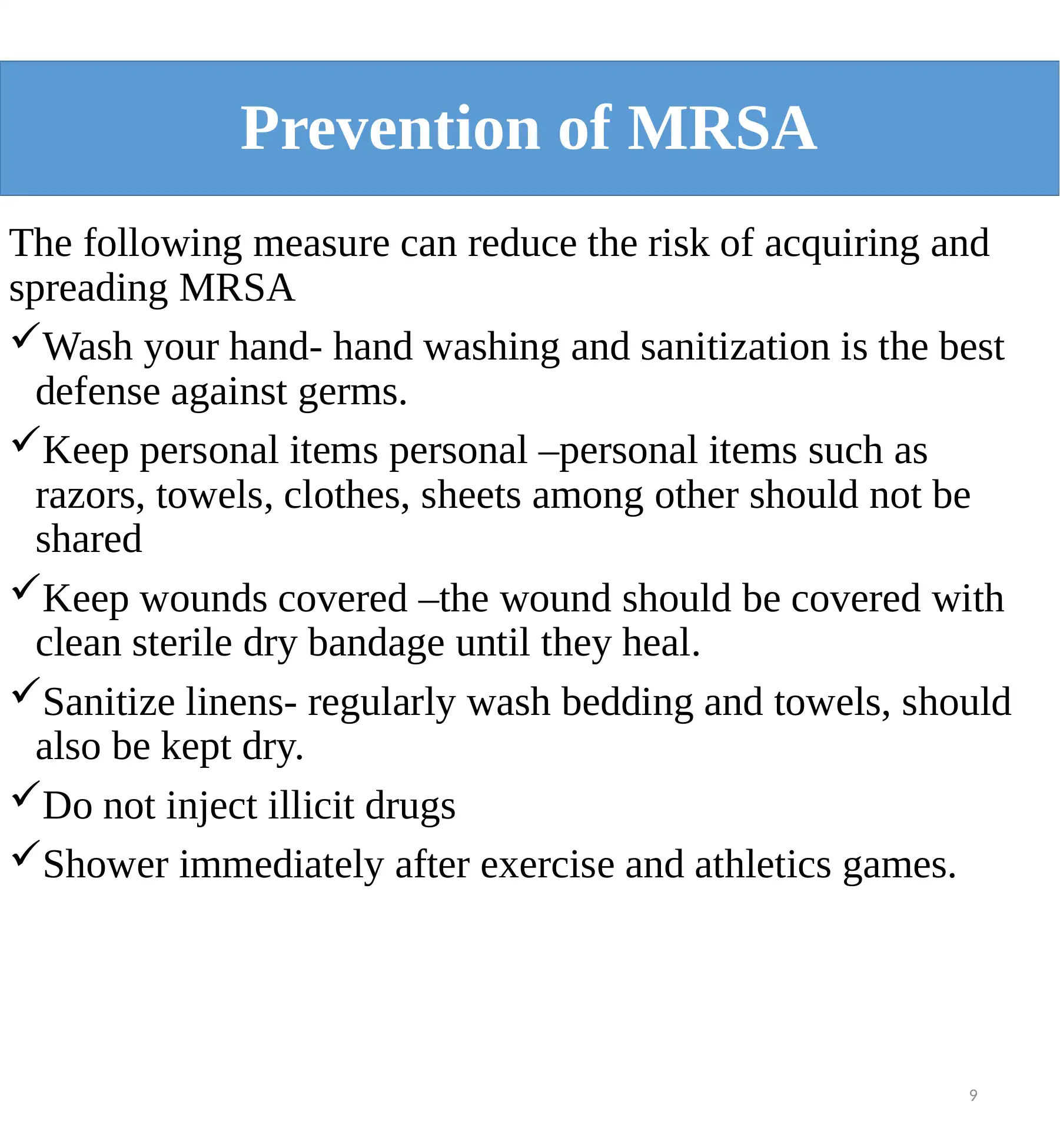
9
Prevention of MRSA
The following measure can reduce the risk of acquiring and
spreading MRSA
Wash your hand- hand washing and sanitization is the best
defense against germs.
Keep personal items personal –personal items such as
razors, towels, clothes, sheets among other should not be
shared
Keep wounds covered –the wound should be covered with
clean sterile dry bandage until they heal.
Sanitize linens- regularly wash bedding and towels, should
also be kept dry.
Do not inject illicit drugs
Shower immediately after exercise and athletics games.
Prevention of MRSA
The following measure can reduce the risk of acquiring and
spreading MRSA
Wash your hand- hand washing and sanitization is the best
defense against germs.
Keep personal items personal –personal items such as
razors, towels, clothes, sheets among other should not be
shared
Keep wounds covered –the wound should be covered with
clean sterile dry bandage until they heal.
Sanitize linens- regularly wash bedding and towels, should
also be kept dry.
Do not inject illicit drugs
Shower immediately after exercise and athletics games.
⊘ This is a preview!⊘
Do you want full access?
Subscribe today to unlock all pages.

Trusted by 1+ million students worldwide
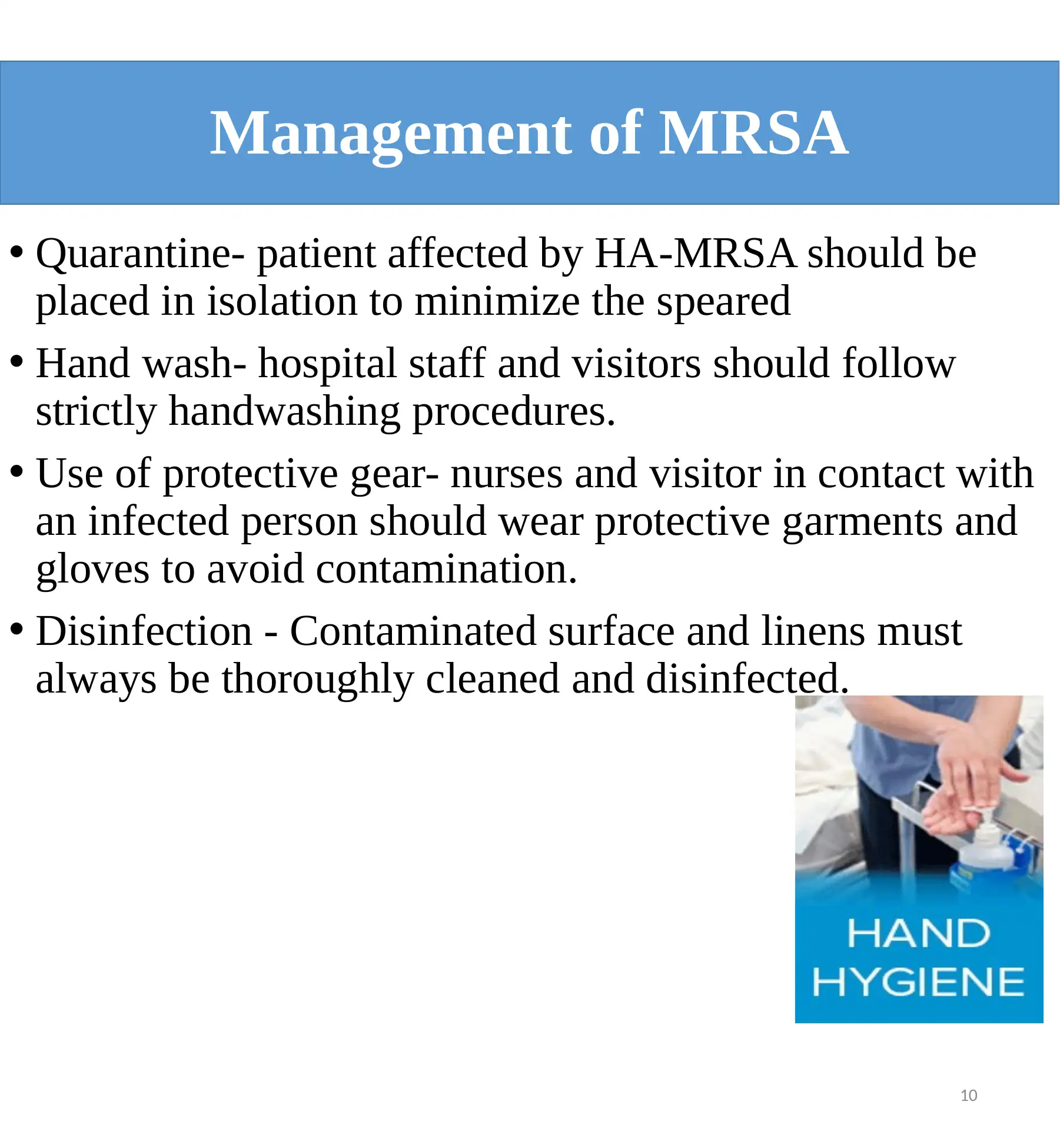
10
Management of MRSA
• Quarantine- patient affected by HA-MRSA should be
placed in isolation to minimize the speared
• Hand wash- hospital staff and visitors should follow
strictly handwashing procedures.
• Use of protective gear- nurses and visitor in contact with
an infected person should wear protective garments and
gloves to avoid contamination.
• Disinfection - Contaminated surface and linens must
always be thoroughly cleaned and disinfected.
Management of MRSA
• Quarantine- patient affected by HA-MRSA should be
placed in isolation to minimize the speared
• Hand wash- hospital staff and visitors should follow
strictly handwashing procedures.
• Use of protective gear- nurses and visitor in contact with
an infected person should wear protective garments and
gloves to avoid contamination.
• Disinfection - Contaminated surface and linens must
always be thoroughly cleaned and disinfected.
Paraphrase This Document
Need a fresh take? Get an instant paraphrase of this document with our AI Paraphraser
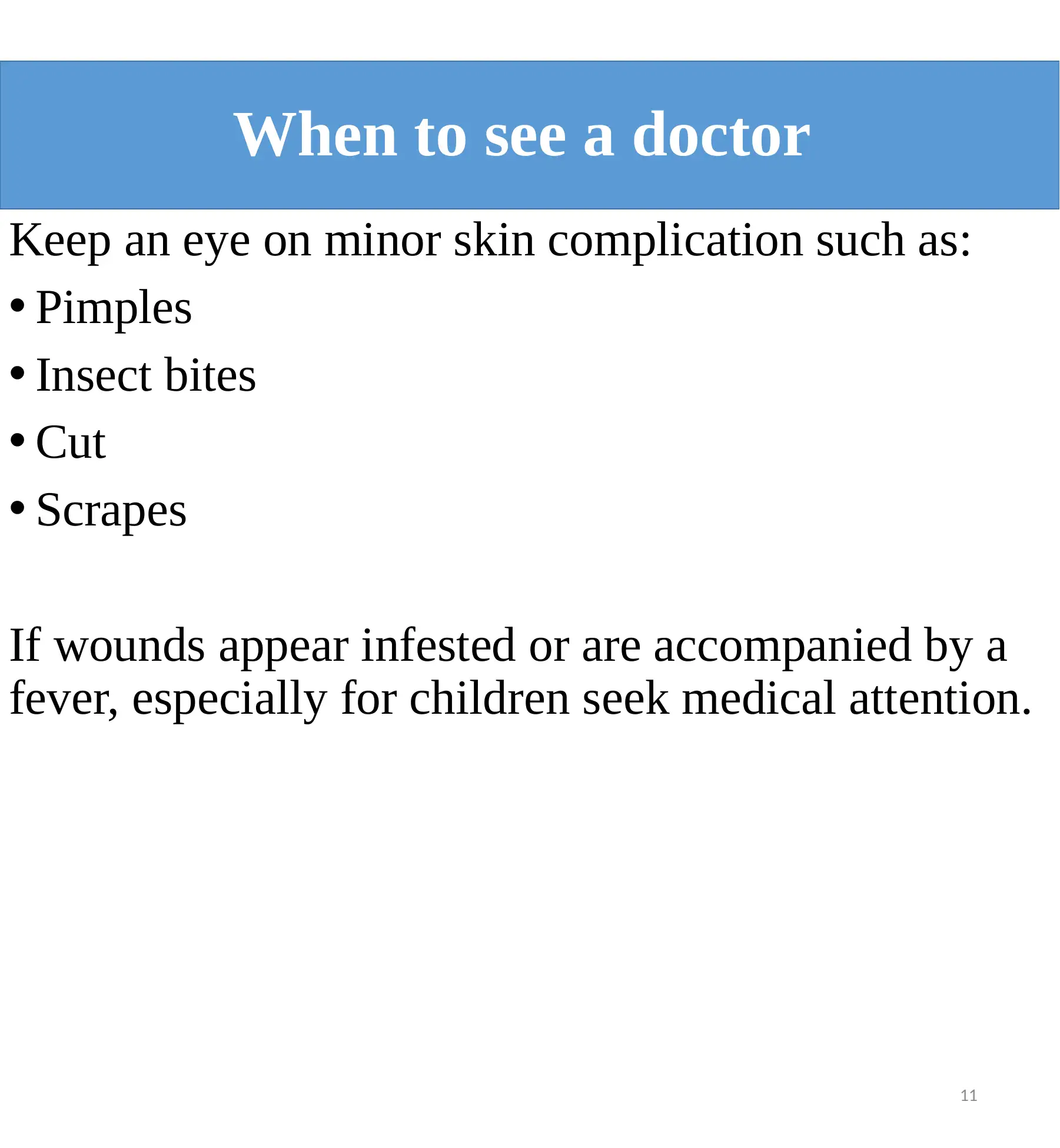
11
When to see a doctor
Keep an eye on minor skin complication such as:
• Pimples
• Insect bites
• Cut
• Scrapes
If wounds appear infested or are accompanied by a
fever, especially for children seek medical attention.
When to see a doctor
Keep an eye on minor skin complication such as:
• Pimples
• Insect bites
• Cut
• Scrapes
If wounds appear infested or are accompanied by a
fever, especially for children seek medical attention.
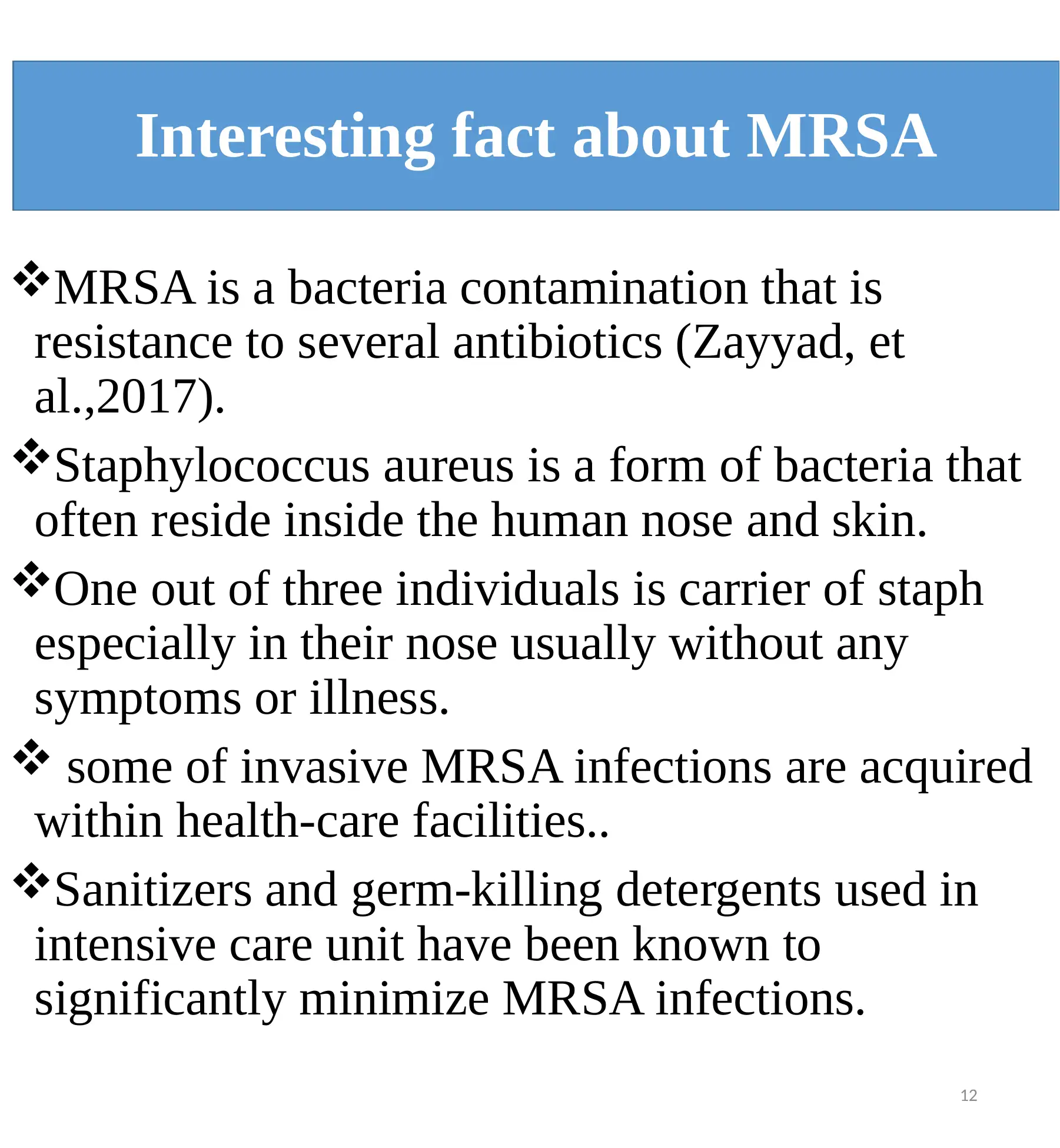
12
Interesting fact about MRSA
MRSA is a bacteria contamination that is
resistance to several antibiotics (Zayyad, et
al.,2017).
Staphylococcus aureus is a form of bacteria that
often reside inside the human nose and skin.
One out of three individuals is carrier of staph
especially in their nose usually without any
symptoms or illness.
some of invasive MRSA infections are acquired
within health-care facilities..
Sanitizers and germ-killing detergents used in
intensive care unit have been known to
significantly minimize MRSA infections.
Interesting fact about MRSA
MRSA is a bacteria contamination that is
resistance to several antibiotics (Zayyad, et
al.,2017).
Staphylococcus aureus is a form of bacteria that
often reside inside the human nose and skin.
One out of three individuals is carrier of staph
especially in their nose usually without any
symptoms or illness.
some of invasive MRSA infections are acquired
within health-care facilities..
Sanitizers and germ-killing detergents used in
intensive care unit have been known to
significantly minimize MRSA infections.
⊘ This is a preview!⊘
Do you want full access?
Subscribe today to unlock all pages.

Trusted by 1+ million students worldwide
1 out of 14
Related Documents
Your All-in-One AI-Powered Toolkit for Academic Success.
+13062052269
info@desklib.com
Available 24*7 on WhatsApp / Email
![[object Object]](/_next/static/media/star-bottom.7253800d.svg)
Unlock your academic potential
Copyright © 2020–2025 A2Z Services. All Rights Reserved. Developed and managed by ZUCOL.





